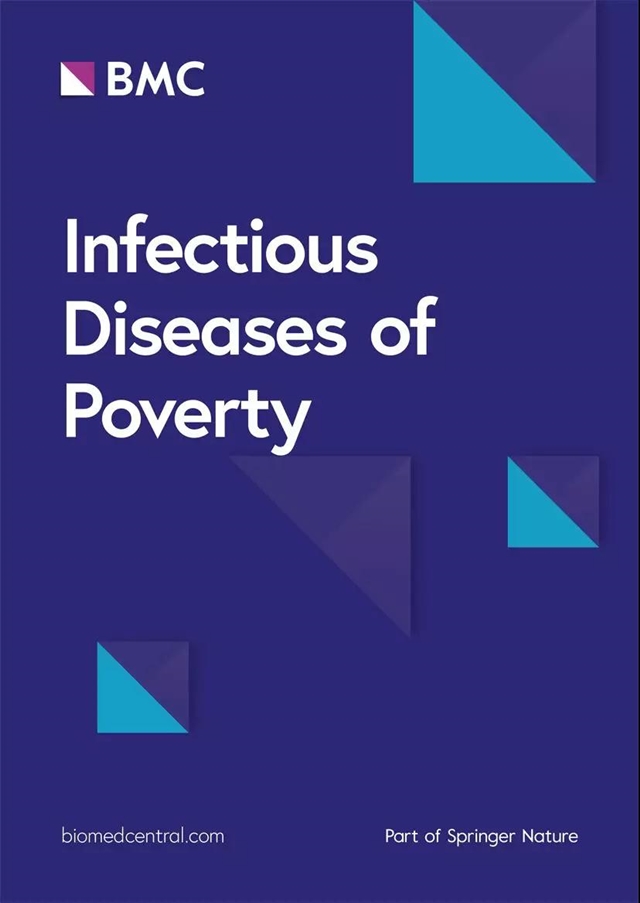日本血吸虫中间蜗牛宿主Oncomelania hupensis的染色体级基因组组装
IF 5.5
1区 医学
Q1 INFECTIOUS DISEASES
引用次数: 0
摘要
日本血吸虫是一种导致人类血吸虫病的寄生扁虫,是中国、菲律宾和印度尼西亚的主要致病原因。日本血吸虫的独特中间宿主是蛇尾蝇(腹足纲:蛇尾蝇科)。获得 O. hupensis 的完整基因组序列将有助于从根本上了解蜗牛生物学及其与日本蜗牛寄生虫的共同进化。组装一个高质量的O. hupehensis参考基因组将为进一步研究蜗牛生物学和控制日本蜗牛传播提供数据。利用长线程测序技术(PacBio Sequel II)从头组装了基因组草案,并用 Illumina 测序数据进行了校正。然后,利用 Hi-C 测序数据在染色体水平上组装了基因组。CAFE 用于分析基因家族的收缩和扩展,PAML 中的 CodeML 模块用于蛋白质编码序列的正选择分析。总长度为 1.46 Gb 的高质量 O. hupensis 基因组包含 17 条独特的全长染色体(2n = 34),其中等位基因 N50 为 1.35 Mb,支架 N50 为 75.08 Mb。此外,95.03% 的等位基因序列锚定在 17 条染色体上。在扫描组装后的基因组后,共预测出 30,604 个蛋白质编码基因。其中,86.67%的基因得到了功能注释。进一步的系统发育分析表明,O. hupensis 是在大约 1.7 亿年前从 Pomacea canaliculata 和 Bellamya purificata 的共同祖先分离出来的。将 O. hupensis 的基因组与其最近的共同祖先进行比较,结果显示 266 个基因家族明显扩大,58 个基因家族明显缩小(P < 0.05)。扩增基因家族的功能富集表明,它们主要参与细胞内、DNA介导的转座、DNA整合和转座酶活性。综合利用多种测序技术,我们成功构建了O. hupensis染色体水平的基因组。这些数据不仅提供了压缩的基因组信息,还有利于今后对该蜗牛种群遗传学的研究以及日本蜗牛与宿主之间的进化研究。本文章由计算机程序翻译,如有差异,请以英文原文为准。
Chromosome-level genome assembly of Oncomelania hupensis: the intermediate snail host of Schistosoma japonicum
Schistosoma japonicum is a parasitic flatworm that causes human schistosomiasis, which is a significant cause of morbidity in China, the Philippines and Indonesia. Oncomelania hupensis (Gastropoda: Pomatiopsidae) is the unique intermediate host of S. japonicum. A complete genome sequence of O. hupensis will enable the fundamental understanding of snail biology as well as its co-evolution with the S. japonicum parasite. Assembling a high-quality reference genome of O. hupehensis will provide data for further research on the snail biology and controlling the spread of S. japonicum. The draft genome was de novo assembly using the long-read sequencing technology (PacBio Sequel II) and corrected with Illumina sequencing data. Then, using Hi-C sequencing data, the genome was assembled at the chromosomal level. CAFE was used to do analysis of contraction and expansion of the gene family and CodeML module in PAML was used for positive selection analysis in protein coding sequences. A total length of 1.46 Gb high-quality O. hupensis genome with 17 unique full-length chromosomes (2n = 34) of the individual including a contig N50 of 1.35 Mb and a scaffold N50 of 75.08 Mb. Additionally, 95.03% of these contig sequences were anchored in 17 chromosomes. After scanning the assembled genome, a total of 30,604 protein-coding genes were predicted. Among them, 86.67% were functionally annotated. Further phylogenetic analysis revealed that O. hupensis was separated from a common ancestor of Pomacea canaliculata and Bellamya purificata approximately 170 million years ago. Comparing the genome of O. hupensis with its most recent common ancestor, it showed 266 significantly expanded and 58 significantly contracted gene families (P < 0.05). Functional enrichment of the expanded gene families indicated that they were mainly involved with intracellular, DNA-mediated transposition, DNA integration and transposase activity. Integrated use of multiple sequencing technologies, we have successfully constructed the genome at the chromosomal-level of O. hupensis. These data will not only provide the compressive genomic information, but also benefit future work on population genetics of this snail as well as evolutional studies between S. japonicum and the snail host.
求助全文
通过发布文献求助,成功后即可免费获取论文全文。
去求助
来源期刊

Infectious Diseases of Poverty
Medicine-Public Health, Environmental and Occupational Health
CiteScore
16.70
自引率
1.20%
发文量
368
审稿时长
13 weeks
期刊介绍:
Infectious Diseases of Poverty is a peer-reviewed, open access journal that focuses on essential public health questions related to infectious diseases of poverty. It covers a wide range of topics and methods, including the biology of pathogens and vectors, diagnosis and detection, treatment and case management, epidemiology and modeling, zoonotic hosts and animal reservoirs, control strategies and implementation, new technologies, and their application.
The journal also explores the impact of transdisciplinary or multisectoral approaches on health systems, ecohealth, environmental management, and innovative technologies. It aims to provide a platform for the exchange of research and ideas that can contribute to the improvement of public health in resource-limited settings.
In summary, Infectious Diseases of Poverty aims to address the urgent challenges posed by infectious diseases in impoverished populations. By publishing high-quality research in various areas, the journal seeks to advance our understanding of these diseases and contribute to the development of effective strategies for prevention, diagnosis, and treatment.
 求助内容:
求助内容: 应助结果提醒方式:
应助结果提醒方式:


